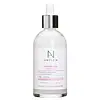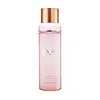What's inside
What's inside
 Key Ingredients
Key Ingredients

 Benefits
Benefits

 Concerns
Concerns

No concerns
 Ingredients Side-by-side
Ingredients Side-by-side

Water
Skin ConditioningButylene Glycol
HumectantGlycerin
HumectantPropanediol
SolventDiglycerin
HumectantBeta-Glucan
Skin Conditioning1,2-Hexanediol
Skin ConditioningNiacinamide
SmoothingBetaine
HumectantMethyl Gluceth-20
HumectantTrehalose
HumectantOctyldodecanol
EmollientAdenosine
Skin ConditioningForsythia Suspensa Fruit Extract
AntioxidantHydrogenated Lecithin
EmulsifyingCeramide 3
Skin ConditioningArginine
MaskingAllantoin
Skin ConditioningBrassica Campestris Sterols
EmollientCholesterol
EmollientCeramide 2
Skin ConditioningCeramide 1
Skin ConditioningXylitylglucoside
HumectantHydroxyethyl Acrylate/Sodium Acryloyldimethyl Taurate Copolymer
Emulsion StabilisingAnhydroxylitol
HumectantXanthan Gum
EmulsifyingCarbomer
Emulsion StabilisingXylitol
HumectantCaprylyl Glycol
EmollientMacadamia Integrifolia Seed Oil
Skin ConditioningCaprylic/Capric Triglyceride
MaskingPhytosteryl/Behenyl/Octyldodecyl Lauroyl Glutamate
Skin ConditioningPolyglyceryl-10 Oleate
Skin ConditioningCetyl Phosphate
EmulsifyingDisodium EDTA
Water, Butylene Glycol, Glycerin, Propanediol, Diglycerin, Beta-Glucan, 1,2-Hexanediol, Niacinamide, Betaine, Methyl Gluceth-20, Trehalose, Octyldodecanol, Adenosine, Forsythia Suspensa Fruit Extract, Hydrogenated Lecithin, Ceramide 3, Arginine, Allantoin, Brassica Campestris Sterols, Cholesterol, Ceramide 2, Ceramide 1, Xylitylglucoside, Hydroxyethyl Acrylate/Sodium Acryloyldimethyl Taurate Copolymer, Anhydroxylitol, Xanthan Gum, Carbomer, Xylitol, Caprylyl Glycol, Macadamia Integrifolia Seed Oil, Caprylic/Capric Triglyceride, Phytosteryl/Behenyl/Octyldodecyl Lauroyl Glutamate, Polyglyceryl-10 Oleate, Cetyl Phosphate, Disodium EDTA
Collagen Extract
Skin ConditioningPropanediol
SolventButylene Glycol
HumectantNiacinamide
Smoothing1,2-Hexanediol
Skin ConditioningPunica Granatum Flower Extract
Skin ConditioningCandida/Garcinia Cambogia Ferment
Zea Mays Germ Oil
EmollientActinidia Chinensis Fruit Extract
EmollientChlorella Vulgaris Extract
Skin ConditioningEel Extract
HumectantCamellia Sinensis Leaf Extract
AntimicrobialSchisandra Chinensis Callus Extract
Skin ProtectingCurcuma Longa Root Extract
MaskingHydrolyzed Collagen
EmollientUlmus Davidiana Root Extract
Skin ConditioningSodium Hyaluronate
HumectantHyaluronic Acid
HumectantHydrolyzed Hyaluronic Acid
HumectantCeteareth-12
EmulsifyingGlycerin
HumectantGlyceryl Stearate
EmollientPolyglyceryl-2 Oleate
EmulsifyingPEG-60 Hydrogenated Castor Oil
EmulsifyingCeteareth-20
CleansingCetearyl Isononanoate
EmollientCetyl Palmitate
EmollientOctyldodeceth-16
EmulsifyingEthylhexylglycerin
Skin ConditioningAdenosine
Skin ConditioningSodium Citrate
BufferingCitric Acid
BufferingSoluble Proteoglycan
Skin ConditioningHydrolyzed Sodium Hyaluronate
Skin ConditioningHydroxypropyltrimonium Hyaluronate
PEG-9 Diglycidyl Ether/Sodium Hyaluronate Crosspolymer
Skin ConditioningPotassium Hyaluronate
Skin ConditioningSodium Acetylated Hyaluronate
HumectantSodium Dna
Skin ConditioningDimethylsilanol Hyaluronate
HumectantWater
Skin ConditioningCetearyl Alcohol
EmollientDisodium EDTA
Phenoxyethanol
PreservativeSodium Benzoate
MaskingParfum
MaskingGardenia Taitensis Callus Extract
AntioxidantCollagen Extract, Propanediol, Butylene Glycol, Niacinamide, 1,2-Hexanediol, Punica Granatum Flower Extract, Candida/Garcinia Cambogia Ferment, Zea Mays Germ Oil, Actinidia Chinensis Fruit Extract, Chlorella Vulgaris Extract, Eel Extract, Camellia Sinensis Leaf Extract, Schisandra Chinensis Callus Extract, Curcuma Longa Root Extract, Hydrolyzed Collagen, Ulmus Davidiana Root Extract, Sodium Hyaluronate, Hyaluronic Acid, Hydrolyzed Hyaluronic Acid, Ceteareth-12, Glycerin, Glyceryl Stearate, Polyglyceryl-2 Oleate, PEG-60 Hydrogenated Castor Oil, Ceteareth-20, Cetearyl Isononanoate, Cetyl Palmitate, Octyldodeceth-16, Ethylhexylglycerin, Adenosine, Sodium Citrate, Citric Acid, Soluble Proteoglycan, Hydrolyzed Sodium Hyaluronate, Hydroxypropyltrimonium Hyaluronate, PEG-9 Diglycidyl Ether/Sodium Hyaluronate Crosspolymer, Potassium Hyaluronate, Sodium Acetylated Hyaluronate, Sodium Dna, Dimethylsilanol Hyaluronate, Water, Cetearyl Alcohol, Disodium EDTA, Phenoxyethanol, Sodium Benzoate, Parfum, Gardenia Taitensis Callus Extract
 Reviews
Reviews

Ingredients Explained
These ingredients are found in both products.
Ingredients higher up in an ingredient list are typically present in a larger amount.
1,2-Hexanediol is a synthetic liquid and another multi-functional powerhouse.
It is a:
- Humectant, drawing moisture into the skin
- Emollient, helping to soften skin
- Solvent, dispersing and stabilizing formulas
- Preservative booster, enhancing the antimicrobial activity of other preservatives
Adenosine is in every living organism. It is one of four components in nucleic acids that helps store our DNA.
Adenosine has many benefits when used. These benefits include hydrating the skin, smoothing skin, and reducing wrinkles. Once applied, adenosine increases collagen production. It also helps with improving firmness and tissue repair.
Studies have found adenosine may also help with wound healing.
In skincare products, Adenosine is usually derived from yeast.
Learn more about AdenosineButylene Glycol (or BG) is used within cosmetic products for a few different reasons:
Overall, Butylene Glycol is a safe and well-rounded ingredient that works well with other ingredients.
Though this ingredient works well with most skin types, some people with sensitive skin may experience a reaction such as allergic rashes, closed comedones, or itchiness.
Learn more about Butylene GlycolDisodium EDTA plays a role in making products more stable by aiding other preservatives.
It is a chelating agent, meaning it neutralizes metal ions that may be found in a product.
Disodium EDTA is a salt of edetic acid and is found to be safe in cosmetic ingredients.
Learn more about Disodium EDTAGlycerin is already naturally found in your skin. It helps moisturize and protect your skin.
A study from 2016 found glycerin to be more effective as a humectant than AHAs and hyaluronic acid.
As a humectant, it helps the skin stay hydrated by pulling moisture to your skin. The low molecular weight of glycerin allows it to pull moisture into the deeper layers of your skin.
Hydrated skin improves your skin barrier; Your skin barrier helps protect against irritants and bacteria.
Glycerin has also been found to have antimicrobial and antiviral properties. Due to these properties, glycerin is often used in wound and burn treatments.
In cosmetics, glycerin is usually derived from plants such as soybean or palm. However, it can also be sourced from animals, such as tallow or animal fat.
This ingredient is organic, colorless, odorless, and non-toxic.
Glycerin is the name for this ingredient in American English. British English uses Glycerol/Glycerine.
Learn more about GlycerinNiacinamide is a multitasking form of vitamin B3 that strengthens the skin barrier, reduces pores and dark spots, regulates oil, and improves signs of aging.
And the best part? It's gentle and well-tolerated by most skin types, including sensitive and reactive skin.
You might have heard of "niacin flush", or the reddening of skin that causes itchiness. Niacinamide has not been found to cause this.
In very rare cases, some individuals may not be able to tolerate niacinamide at all or experience an allergic reaction to it.
If you are experiencing flaking, irritation, and dryness with this ingredient, be sure to double check all your products as this ingredient can be found in all categories of skincare.
When incorporating niacinamide into your routine, look out for concentration amounts. Typically, 5% niacinamide provides benefits such as fading dark spots. However, if you have sensitive skin, it is better to begin with a smaller concentration.
When you apply niacinamide to your skin, your body converts it into nicotinamide adenine dinucleotide (NAD). NAD is an essential coenzyme that is already found in your cells as "fuel" and powers countless biological processes.
In your skin, NAD helps repair cell damage, produce new healthy cells, support collagen production, strengthen the skin barrier, and fight environmental stressors (like UV and pollution).
Our natural NAD levels start to decline with age, leading to slower skin repair, visible aging, and a weaker skin barrier. By providing your skin niacinamide, you're recharging your skin's NAD levels. This leads to stronger, healthier, and younger looking skin.
Another name for vitamin B3 is nicotinamide. This vitamin is water-soluble and our bodies don't store it. We obtain Vitamin B3 from either food or skincare. Meat, fish, wheat, yeast, and leafy greens contain vitamin B3.
The type of niacinamide used in skincare is synthetically created.
Learn more about NiacinamidePropanediol is an all-star ingredient. It softens, hydrates, and smooths the skin.
It’s often used to:
Propanediol is not likely to cause sensitivity and considered safe to use. It is derived from corn or petroleum with a clear color and no scent.
Learn more about PropanediolWater. It's the most common cosmetic ingredient of all. You'll usually see it at the top of ingredient lists, meaning that it makes up the largest part of the product.
So why is it so popular? Water most often acts as a solvent - this means that it helps dissolve other ingredients into the formulation.
You'll also recognize water as that liquid we all need to stay alive. If you see this, drink a glass of water. Stay hydrated!
Learn more about Water